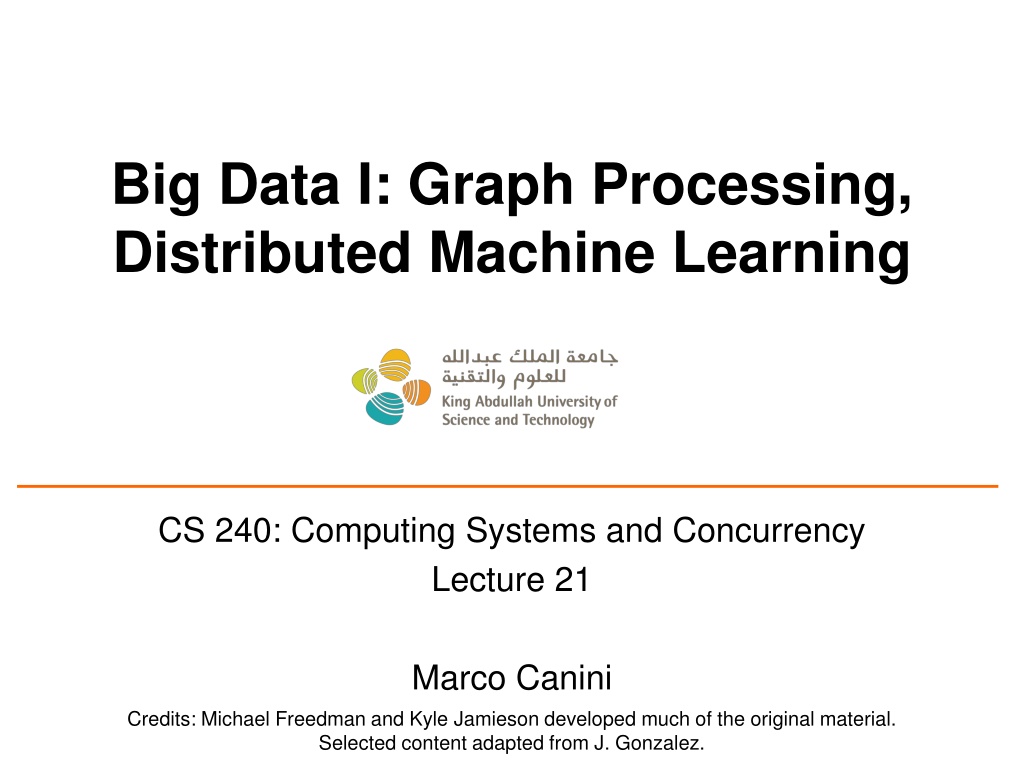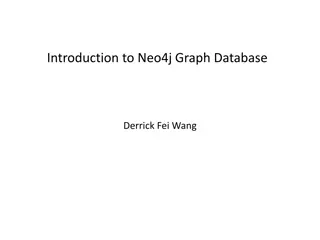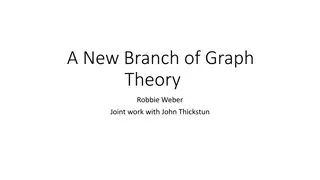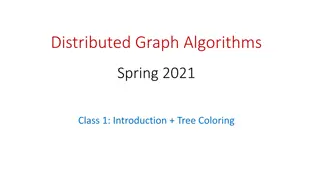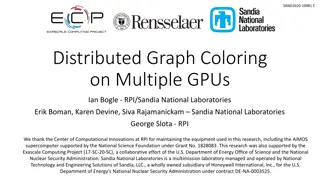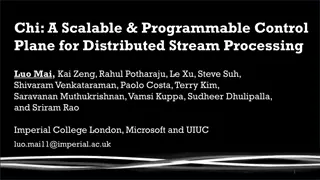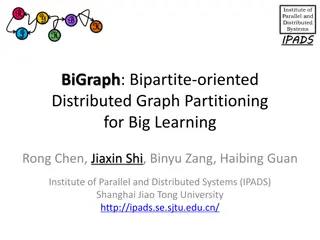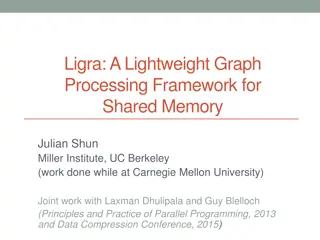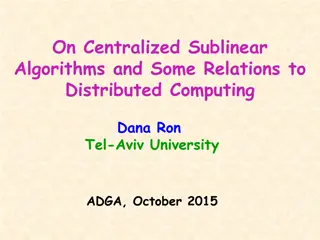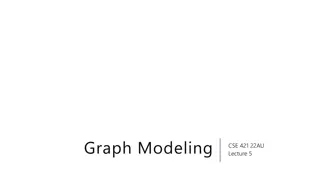Distributed Machine Learning and Graph Processing Overview
Big Data encompasses vast amounts of data from sources like Flickr, Facebook, and YouTube, requiring efficient processing systems. This lecture explores the shift towards using high-level parallel abstractions, such as MapReduce and Hadoop, to design and implement Big Learning systems. Data-parallel computation techniques like word count using partial aggregation and synchronization barriers are covered. The fault tolerance in MapReduce ensures reliable processing and storage of intermediate results during distributed machine learning tasks.
Download Presentation

Please find below an Image/Link to download the presentation.
The content on the website is provided AS IS for your information and personal use only. It may not be sold, licensed, or shared on other websites without obtaining consent from the author.If you encounter any issues during the download, it is possible that the publisher has removed the file from their server.
You are allowed to download the files provided on this website for personal or commercial use, subject to the condition that they are used lawfully. All files are the property of their respective owners.
The content on the website is provided AS IS for your information and personal use only. It may not be sold, licensed, or shared on other websites without obtaining consent from the author.
E N D
Presentation Transcript
Big Data I: Graph Processing, Distributed Machine Learning CS 240: Computing Systems and Concurrency Lecture 21 Marco Canini Credits: Michael Freedman and Kyle Jamieson developed much of the original material. Selected content adapted from J. Gonzalez.
Big Data is Everywhere 10 Billion Flickr Photos Avg. 1 Million/day 1.4 Billion daily active Facebook Users 400 Hours a Minute YouTube 44 Million Wikipedia Pages Machine learning is a reality How will we design and implement Big Learning systems? 2
We could use . Threads, Locks, & Messages Low-level parallel primitives
Shift Towards Use Of Parallelism in ML and data analytics GPUs Multicore Clusters Clouds Supercomputers Programmers repeatedly solve the same parallel design challenges: Race conditions, distributed state, communication Resulting code is very specialized: Difficultto maintain, extend, debug Idea: Avoid these problems by using high-level abstractions 4
... a better answer: MapReduce / Hadoop Build learning algorithms on top of high-level parallel abstractions
Ex: Word count using partial aggregation 1. Compute word counts from individual files 2. Then merge intermediate output 3. Compute word count on merged outputs 7
Putting it together map combine partition ( shuffle ) reduce 8
Synchronization Barrier 9
Fault Tolerance in MapReduce Map worker writes intermediate output to local disk, separated by partitioning. Once completed, tells master node Reduce worker told of location of map task outputs, pulls their partition s data from each mapper, execute function across data Note: All-to-all shuffle b/w mappers and reducers Written to disk ( materialized ) b/w each stage 10
MapReduce: Not for Every Task MapReduce greatly simplified large-scale data analysis on unreliable clusters of computers Brought together many traditional CS principles functional primitives; master/slave; replication for fault tolerance Hadoop adopted by many companies Affordable large-scale batch processing for the masses But increasingly people wanted more!
MapReduce: Not for Every Task But increasingly people wanted more: More complex, multi-stage applications More interactive ad-hoc queries Process live data at high throughput and low latency Which are not a good fit for MapReduce
Iterative Algorithms MR doesn t efficiently express iterative algorithms: Iterations Data Data Data Data CPU 1 CPU 1 CPU 1 Data Data Data Data Processor Data Data Data Data Slow CPU 2 CPU 2 CPU 2 Data Data Data Data Data Data Data Data CPU 3 CPU 3 CPU 3 Data Data Data Data Data Data Data Data Barrier Barrier Barrier
MapAbuse: Iterative MapReduce System is not optimized for iteration: Iterations Data Data Data Data CPU 1 CPU 1 CPU 1 Data Data Data Data Startup Penalty Startup Penalty Startup Penalty Disk Penalty Disk Penalty Disk Penalty Data Data Data Data CPU 2 CPU 2 CPU 2 Data Data Data Data Data Data Data Data CPU 3 CPU 3 CPU 3 Data Data Data Data Data Data Data Data
In-Memory Data-Parallel Computation 15
Spark: Resilient Distributed Datasets Let s think of just having a big block of RAM, partitioned across machines And a series of operators that can be executed in parallel across the different partitions That s basically Spark A distributed memory abstraction that is both fault-tolerant and efficient
Spark: Resilient Distributed Datasets Restricted form of distributed shared memory Immutable, partitioned collections of records Can only be built through coarse-grained deterministic transformations (map, filter, join, ) They are called Resilient Distributed Datasets (RDDs) Efficient fault recovery using lineage Log one operation to apply to many elements Recompute lost partitions on failure No cost if nothing fails
Spark Programming Interface Language-integrated API in Scala (+ Python) Usable interactively via Spark shell Provides: Resilient distributed datasets (RDDs) Operations on RDDs: deterministic transformations (build new RDDs), actions (compute and output results) Control of each RDD s partitioning (layout across nodes) and persistence (storage in RAM, on disk, etc)
Example: Log Mining Load error messages from a log into memory, then interactively search for various patterns Msgs. 1 Base RDD Transformed RDD lines = spark.textFile( hdfs://... ) Worker results errors = lines.filter(_.startsWith( ERROR )) tasks Block 1 messages = errors.map(_.split( \t )(2)) Master messages.persist() Action messages.filter(_.contains( foo )).count Msgs. 2 messages.filter(_.contains( bar )).count Worker Msgs. 3 Block 2 Worker Block 3
In-Memory Data Sharing . . . iter. 1 iter. 2 Input query 1 one-time processing query 2 query 3 Input . . .
Efficient Fault Recovery via Lineage Maintain a reliable log of applied operations . . . iter. 1 iter. 2 Input Recompute lost partitions on failure query 1 one-time processing query 2 query 3 Input . . .
Generality of RDDs Despite their restrictions, RDDs can express many parallel algorithms These naturally apply the same operation to many items Unify many programming models Data flow models: MapReduce, Dryad, SQL, Specialized models for iterative apps: BSP (Pregel), iterative MapReduce (Haloop), bulk incremental, Support new apps that these models don t Enables apps to efficiently intermix these models
Spark Operations flatMap union join cogroup cross mapValues map filter sample groupByKey reduceByKey sortByKey Transformations (define a new RDD) collect reduce count save lookupKey take Actions (return a result to driver program)
Task Scheduler Wide dependencies DAG of stages to execute Pipelines functions within a stage Locality & data reuse aware Partitioning-aware to avoid shuffles B: A: G: Stage 1 groupBy F: D: C: map E: join Stage 2 union Stage 3 = cached data partition Narrow dependencies
Spark Summary Global aggregate computations that produce program state compute the count() of an RDD, compute the max diff, etc. Loops! Spark makes it much easier to do multi-stage MapReduce Built-in abstractions for some other common operations like joins See also Apache Flink for a flexible big data platform
Graphs are Everywhere Collaborative Filtering Social Network Users Netflix Movies Probabilistic Analysis Text Analysis Docs Wiki Words
Properties of Graph Parallel Algorithms Dependency Graph Factored Computation Iterative Computation What I Like What My Friends Like
ML Tasks Beyond Data-Parallelism Data-Parallel Graph-Parallel Map Reduce ? Feature Extraction Cross Validation Graphical Models Gibbs Sampling Belief Propagation Variational Opt. Semi-Supervised Learning Label Propagation CoEM Computing Sufficient Statistics Collaborative Filtering Tensor Factorization Graph Analysis PageRank Triangle Counting 29
The GraphLab Framework Graph Based Data Representation Update Functions User Computation Consistency Model 30
Data Graph Data is associated with both vertices and edges Graph: Social Network Vertex Data: User profile Current interests estimates Edge Data: Relationship (friend, classmate, relative) 31
Distributed Data Graph Partition the graph across multiple machines: 32
Distributed Data Graph Ghost vertices maintain adjacency structure and replicate remote data. ghost vertices 33
The GraphLab Framework Graph Based Data Representation Update Functions User Computation Consistency Model 34
Update Function A user-defined program, applied to a vertex; transforms data in scope of vertex Pagerank(scope){ // Update the current vertex data Update function applied (asynchronously) in parallel until convergence Many schedulers available to prioritize computation vertex.PageRank = a ForEach inPage: vertex.PageRank += (1-a) inPage.PageRank // Reschedule Neighbors if needed if vertex.PageRank changes then reschedule_all_neighbors; } Selectively triggers computation at neighbors 35
Distributed Scheduling Each machine maintains a schedule over the vertices it owns a f b b d c c a g h f g e k i i j j h Distributed Consensus used to identify completion 36
Ensuring Race-Free Code How much can computation overlap? 37
The GraphLab Framework Graph Based Data Representation Update Functions User Computation Consistency Model 38
PageRank Revisited Pagerank(scope) { vertex.PageRank = a ForEach inPage: vertex.PageRank += (1-a) inPage.PageRank vertex.PageRank = tmp } 39
Racing PageRank: Bug Pagerank(scope) { vertex.PageRank = a ForEach inPage: vertex.PageRank += (1-a) inPage.PageRank vertex.PageRank = tmp } 41
Racing PageRank: Bug Fix Pagerank(scope) { vertex.PageRank = a ForEach inPage: vertex.PageRank += (1-a) inPage.PageRank vertex.PageRank = tmp tmp tmp } 42
Throughput != Performance Higher Throughput (#updates/sec) No Consistency Potentially Slower Convergence of ML 43
Serializability For every parallel execution, there exists a sequential execution of update functions which produces the same result. time CPU 1 Parallel CPU 2 Single CPU Sequential 44
Serializability Example Write Stronger / Weaker consistency levels available Read User-tunable consistency levels trades off parallelism & consistency Overlapping regions are only read. Update functions onevertex apart can be run in parallel. Edge Consistency 45
Distributed Consistency Solution 1:Chromatic Engine Edge Consistency via Graph Coloring Solution 2: Distributed Locking
Chromatic Distributed Engine Execute tasks on all vertices of color 0 Execute tasks on all vertices of color 0 Ghost Synchronization Completion + Barrier Time Execute tasks on all vertices of color 1 Execute tasks on all vertices of color 1 Ghost Synchronization Completion + Barrier 47
Matrix Factorization Netflix Collaborative Filtering Alternating Least Squares Matrix Factorization Model: 0.5 million nodes, 99 million edges Users Movies Users Netflix D D Movies 48
Netflix Collaborative Filtering vs 4 machines 4 10 16 Ideal 14 d=100 (30M Cycles) d=50 (7.7M Cycles) d=20 (2.1M Cycles) d=5 (1.0M Cycles) D=100 Ideal 12 3 MPI 10 Hadoop Runtime(s) MPI Hadoop Speedup 10 GraphLab 8 D=20 2 10 6 4 GraphLab 2 1 1 10 4 8 16 24 32 40 48 56 64 4 8 16 24 32 40 48 56 64 #Nodes # machines #Nodes # machines (D = 20) 49
Distributed Consistency Solution 1:Chromatic Engine Edge Consistency via Graph Coloring Requires a graph coloring to be available Frequent barriers inefficient when only some vertices active Solution 2: Distributed Locking
